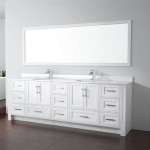How To Paint a Plastic Bathroom Sink
Painting a plastic bathroom sink offers an economical and aesthetically pleasing alternative to complete replacement when the existing fixture suffers from discoloration, scratches, or simply no longer aligns with the desired bathroom décor. Successfully painting a plastic sink requires meticulous preparation, careful application of appropriate primers and paints, and a commitment to allowing sufficient drying time between coats. This guide provides a comprehensive, step-by-step approach to achieving a durable, attractive finish on a plastic bathroom sink.
Surface Preparation: The Foundation for a Lasting Finish
The longevity and visual appeal of a painted plastic sink hinge significantly on the quality of surface preparation. Proper preparation ensures the primer and paint adhere correctly, preventing peeling, chipping, and premature wear. This stage involves thorough cleaning, sanding, and degreasing to create a receptive surface for paint application.
Cleaning: Begin by thoroughly cleaning the sink with a strong degreaser or household cleaner specifically designed to remove soap scum, grime, and mineral deposits. These substances can impede paint adhesion, leading to an uneven and easily damaged finish. Apply the cleaner according to the manufacturer's instructions, paying particular attention to areas around the drain, faucet, and any corners or crevices. Rinse the sink thoroughly with clean water to remove all traces of the cleaner. Allow the sink to dry completely before proceeding.
Sanding: Sanding the plastic surface is crucial for creating a mechanical bond between the sink and the primer. Employ progressively finer grits of sandpaper. Start with a medium-grit sandpaper (around 220-grit) to lightly abrade the surface. This creates microscopic scratches that provide "tooth" for the primer to grip. Avoid excessive pressure during sanding, as this can gouge the plastic. The goal is to dull the glossy finish, not to remove layers of plastic. After sanding with the 220-grit sandpaper, smooth the surface with a finer grit (around 320-400-grit). This will remove any rough edges created by the initial sanding and create a smoother surface for the primer. After each sanding session, thoroughly wipe down the sink with a tack cloth to remove all sanding dust. Dust particles can compromise the paint finish and create imperfections.
Masking: Before applying primer, carefully mask off any areas that should not be painted, such as the faucet, drain, and surrounding countertop. Use painter's tape designed for delicate surfaces to prevent damage to these areas. Ensure the tape is applied firmly and smoothly to create a clean, crisp paint line. For added protection, consider using plastic sheeting or newspaper to cover larger areas around the sink.
Degreasing (Again): Even after cleaning and sanding, residual oils from handling the sink can remain on the surface. Wipe down the entire sink again with a degreaser or isopropyl alcohol to remove any remaining contaminants. This step is essential for ensuring optimal primer adhesion.
Priming and Painting: Achieving a Durable and Attractive Finish
Selecting the correct primer and paint is paramount for achieving a long-lasting and aesthetically pleasing finish on a plastic sink. Choose products specifically formulated for use on plastic surfaces, as these offer superior adhesion and flexibility. Consider the desired finish (gloss, semi-gloss, matte) and the color scheme of the bathroom when selecting paint.
Primer Application: Apply a thin, even coat of primer specifically designed for plastic surfaces. Epoxy-based primers are often recommended for their excellent adhesion and resistance to water. Apply the primer using a high-quality brush, roller, or spray can, following the manufacturer's instructions. Multiple thin coats of primer are preferable to a single thick coat, as this minimizes the risk of drips and runs. Allow the primer to dry completely according to the manufacturer's instructions, typically 24-48 hours. Lightly sand the primed surface with a fine-grit sandpaper (400-600-grit) to remove any imperfections and create an even smoother surface for the paint. Wipe down the sink with a tack cloth to remove any sanding dust.
Paint Application: Choose a paint specifically formulated for use in damp environments, such as an epoxy-based paint or a two-part polyurethane paint. These paints offer excellent water resistance and durability, which are essential for a bathroom sink. Apply the paint in thin, even coats, using a high-quality brush, roller, or spray can. Multiple thin coats are preferable to a single thick coat. Allow each coat of paint to dry completely according to the manufacturer's instructions, typically 24-48 hours. Lightly sand the painted surface with a very fine-grit sandpaper (600-800-grit) between coats to remove any imperfections and create an even smoother finish. This step is particularly important for achieving a high-gloss finish. Wipe down the sink with a tack cloth to remove any sanding dust before applying the next coat of paint.
Curing Time: After applying the final coat of paint, allow the sink to cure completely for the recommended time specified by the paint manufacturer. This is crucial for allowing the paint to harden and develop its full water resistance. Typically, this curing time is several days to a week. Avoid using the sink during the curing period to prevent damage to the freshly painted surface.
Materials and Tools: Essential Components for Success
Having the right materials and tools on hand before starting the project is essential for ensuring a smooth and efficient painting process. Gathering all necessary supplies beforehand prevents interruptions and minimizes the risk of errors.
Cleaning Supplies: Degreaser, household cleaner, clean water, sponges, rags, tack cloth.
Sanding Supplies: Medium-grit sandpaper (220-grit), fine-grit sandpaper (320-400-grit), very fine-grit sandpaper (600-800-grit), sanding block (optional).
Masking Supplies: Painter's tape (for delicate surfaces), plastic sheeting or newspaper.
Priming and Painting Supplies: Primer for plastic surfaces (epoxy-based recommended), paint for damp environments (epoxy-based or two-part polyurethane recommended), high-quality brush, roller, or spray can, paint tray (if using a roller or brush), stir sticks.
Safety Equipment: Safety glasses, gloves, respirator or dust mask (especially when sanding or spraying).
Optional Tools: Heat gun (for accelerating drying time, use with caution), drop cloth to protect flooring.
Careful consideration of these elements will significantly improve the likelihood of a successful and durable paint job on a plastic bathroom sink.

Can I Paint A Bathroom Sink That Is Faux Marble And Plastic Hometalk

How To Paint A Plastic Slop Sink Hunker

How To Paint A Sink It All Started With

Can I Paint A Bathroom Sink That Is Faux Marble And Plastic Hometalk

How To Paint A Sink Painting Diy Home Improvements On Budget Remodel

Suggestions For Painting A Laundry Sink Hometalk

Paint Your Bathroom Sink Hometalk

Spray Painted Laundry Tub

Paint Plastic Sink Tiktok Search

Bathroom Countertop Makeover With Envirotex Lite Pour On High Gloss Finish
Related Posts







